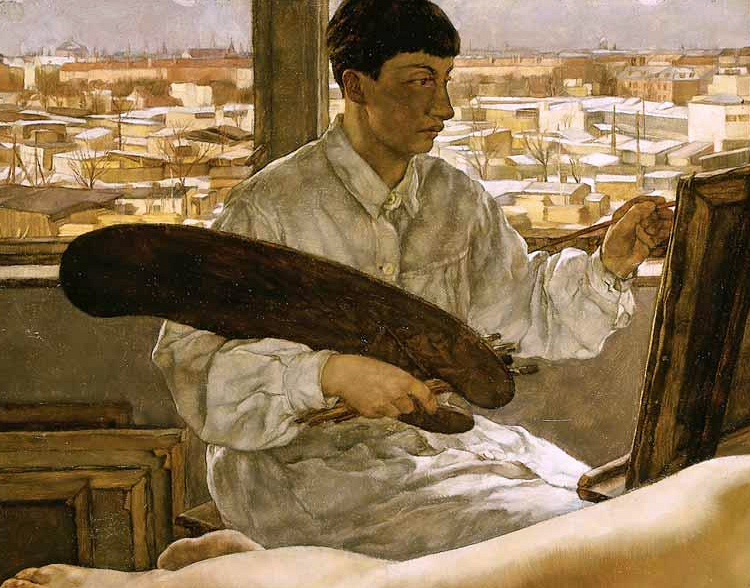 |
| Selbstporträt mit einer Katze, 1928. |
 |
| Der Motorradfahrer/Am Motorrad, 1929. |
 |
| In meinem Atelier, 1928. |
 |
| Mongole, circa 1927. |
 |
| Russisches Mädchen, circa 1928. |
 |
| Polly Tieck, 1929. |
 |
| Mackie Messer, circa 1932. (With self-portrait.) |
 |
| Gutsbesitzersohn, 1934. |
 |
| Sitzende Frau mit roter Baskenmütze, 1931. |
 |
| Im Gasthaus, 1927. |
 |
| Im Gasthaus, circa 1927. |
 |
| ND. |
 |
| Liegendes Mädchen, circa 1931. |
 |
| Rauchender Mann - Wilhelm Thiermann, circa 1930. |
 |
| Ich und mein Modell, circa 1929-30. |
 |
| Vor dem Spiegel, 1930-31. |
 |
| Tennisspielerin, 1929. |
 |
| Frau Im Cafe - Lotte Fischler, 1939. |
 |
| Freifrau Alice Lagerbielke, 1938. |
 |
| Traute Rose mit weißen Handschuhen, circa 1931. |
 |
| Weiblicher Rückenakt, circa 1931. |
 |
| Anna Karger, circa 1933. |
 |
| Anna Karger, circa early 1930s. |
 |
| Junge mit Kasperpuppe - Wolfgang Karger, 1933. |
 |
| Mädchen mit Katze, circa 1932-33. |
 |
| Abend über Potsdam, 1930. |
 |
| Morgentoilette, 1930. |
 |
| Der spanische Kellner, 1958. |
 |
| Dame in blau mit Schleierhut, circa 1939. |
 |
| Russisches Mädchen mit Puderdose, 1928. |
 |
| Selbstporträt im Atelier, circa 1927. |
 |
| Kopf eines jungen Mannes, circa 1926. |
 |
| Madeleine, circa early 1940s. |
 |
| Selbstporträt, circa late 1920s. |
*
 |
| Posing with her painting Abend über Potsdam, circa 1930. |
Lotte Laserstein (28 November 1898, Preussisch Holland, East Prussia – 21 January 1993, Kalmar, Sweden), German figurative painter and portrait artist. She is said to have declared at the age of eleven that she would never marry, but devote her life to painting. In 1921 she was one of the first female students admitted to the Berlin Academy, where she would study with the painter Erich Wolfsfeld; in her last two years at the academy she was his
Atelier Meisterschal (star pupil.) She would be greatly influenced by the nineteenth century realists Adolph Menzel and Wilhelm Leibl, as well as the portraiture of Hans Holbein.
She won the Academy’s Gold Medal in 1925 and after leaving the school set up her own studio in Berlin. She exhibited during the late 1920s, and in 1931 she held her first solo exhibition in Berlin. In 1934, however, labelled under new Nazi racial laws as "three-quarters Jewish", she was barred from exhibiting in public, and in 1935 was forced to abandon her studio. Finally, in 1937, just as her work began to receive critical acclaim, with two paintings hung in that year's Paris Salon, she traveled to an exhibition of her work at the Galleri Modern in Stockholm... and never returned to Germany. She arranged to gain Swedish citizenship the following year through a marriage to a Swedish friend. After great effort, she was able to get her sister out of Germany, but her mother would die at Ravensbruck in 1943. Laserstein spent the rest of her long life in Sweden teaching and working as a portrait painter. Overshadowed for decades by new artistic trends, her early work was "rediscovered" to great acclaim during her last decade of her life. She died at the age of ninety-four.
 |
| Selbstporträt, 1950. (Her best known work, Abend über Potsdam, is in the background - reversed, as the artist would be working from a mirror.) |









































No comments:
Post a Comment